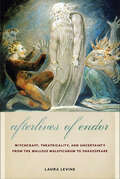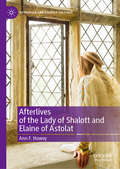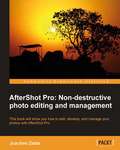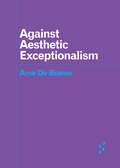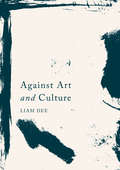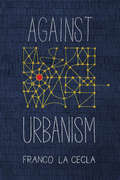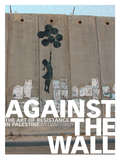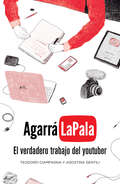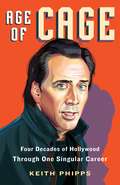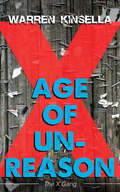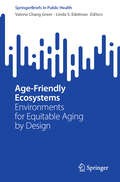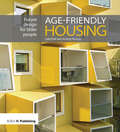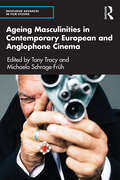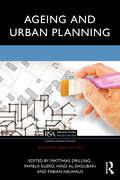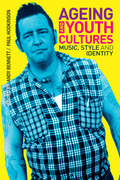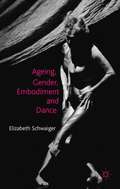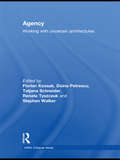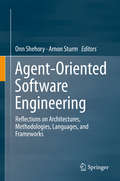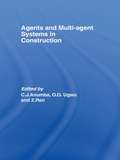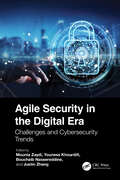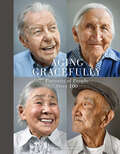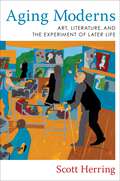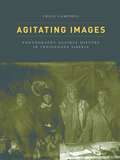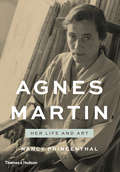- Table View
- List View
Afterlives of Endor: Witchcraft, Theatricality, and Uncertainty from the "Malleus Maleficarum" to Shakespeare
by Laura LevineAfterlives of Endor offers an analysis of the way early modern English literature addressed the period's anxieties about witchcraft and theatricality. What determined whether or not a demonologist imagined a trial as a spectacle? What underlying epistemological constraints governed such choices and what conceptions of witchcraft did these choices reveal? Pairing readings of demonological texts with canonical plays and poetry, Laura Levine examines such questions. Through analyses of manuals and pamphlets about the prosecution of witches—including Reginald Scot's skeptical The Discoverie of Witchcraft (1584), King James VI/I's Daemonologie (1597), and Jean Bodin's De la Demonomanie des Sorciers (1580)—Afterlives of Endor examines the way literary texts such as Shakespeare's The Winter's Tale and The Tempest, Spenser's The Faerie Queene, and Marlowe's Tragicall History of Doctor Faustus address anxieties about witchcraft, illusion, and theatricality. Afterlives of Endor attends to the rhetorical tactics, argumentative investments, and underlying tensions of demonological texts with the scrutiny ordinarily reserved for literary texts.
Afterlives of the Lady of Shalott and Elaine of Astolat (Arthurian and Courtly Cultures)
by Ann F. HoweyThis book investigates adaptations of The Lady of Shalott and Elaine of Astolat in Victorian and post-Victorian popular culture to explore their engagement with medievalism, social constructions of gender, and representations of the role of art in society. Although the figure of Elaine first appeared in medieval texts, including Malory’s Le Morte Darthur, Tennyson’s poems about the Lady and Elaine drew unprecedented response from musicians, artists, and other authors, whose adaptations in some cases inspired further adaptations. With chapters on music, art, and literature (including parody, young people’s literature, and historical fiction and fantasy), this book seeks to trace the evolution of these characters and the ways in which they reinforce or challenge conventional gender roles, represent the present’s relationship to the past, and highlight the power of art.
Aftershot Pro: Non-destructive photo editing and management
by Joachim ZiebsThe book takes a tutorial approach.This book is great for photographers who want to start working with AfterShot Pro. It is assumed that you have a digital camera that can save RAW files to make use of the application. Readers are expected to have one or more RAW files available which can be used for practice alongside this book. Experience with other image editing software is a plus, but not mandatory for this book.
Against Aesthetic Exceptionalism (Forerunners: Ideas First)
by Arne De BoeverReconsiders exceptionalism between aesthetics and politics Here, Arne De Boever proposes the notion of aesthetic exceptionalism to describe the widespread belief that art and artists are exceptional. Against Aesthetic Exceptionalism challenges that belief by focusing on the sovereign artist as genius, as well as the original artwork as the foundation of the art market. Engaging with sculpture, conceptual artwork, and painting by emerging and established artists, De Boever proposes a worldly, democratic notion of unexceptional art as an antidote to the problems of aesthetic exceptionalism.Forerunners: Ideas First Short books of thought-in-process scholarship, where intense analysis, questioning, and speculation take the lead
Against Art and Culture
by Liam DeeOffering a negative definition of art in relation to the concept of culture, this book establishes the concept of 'art/culture' to describe the unity of these two fields around named-labour, idealised creative subjectivity and surplus signification. Contending a conceptual and social reality of a combined 'art/culture' , this book demonstrates that the failure to appreciate the dynamic totality of art and culture by its purported negators is due to almost all existing critiques of art and culture being defences of a 'true' art or culture against 'inauthentic' manifestations, and art thus ultimately restricting creativity to the service of the bourgeois commodity regime. While the evidence that art/culture enables commodification has long been available, the deduction that art/culture itself is fundamentally of the world of commodification has failed to gain traction. By applying a nuanced analysis of both commodification and the larger systems of ideological power, the book considers how the 'surplus' of art/culture is used to legitimate the bourgeois status quo rather than unravel it. It also examines possibilities for a post-art/culture world based on both existing practices that challenge art/culture identity as well as speculations on the integration of play and aesthetics into general social life. An out-and-out negation of art and culture, this book offers a unique contribution to the cultural critique landscape.
Against Urbanism (Green Arcade)
by Franco La CeclaAfter demolishing the myth of the rock star architect with his book Against Architecture, Franco La Cecla now explores the decisive challenges that cities are going to have to confront in the near future. Urban planning and development has become increasingly inadequate in response to the daily realities of life in our cities. Human, economic, ethnic, and environmental factors are systematically overlooked in city planning and housing development, and anachronistic, sterile, and formalistic architecture almost invariably prevails. Never more than today has democracy played itself out in public spaces, sidewalks, and streets. Urban planners and developers, however, are still prisoners of an obsolete vision of passivity which betrays actual city needs and demands. A new urban science is required which can, first of all, guarantee a civil, dignified life for all—urban development which ensures the right to a humane mode of daily living, which has been and still is completely ignored.
Against the Commons: A Radical History of Urban Planning
by Álvaro Sevilla-BuitragoAn alternative history of capitalist urbanization through the lens of the commons Characterized by shared, self-managed access to food, housing, and the basic conditions for a creative life, the commons are essential for communities to flourish and protect spaces of collective autonomy from capitalist encroachment. In a narrative spanning more than three centuries, Against the Commons provides a radical counterhistory of urban planning that explores how capitalism and spatial politics have evolved to address this challenge.Highlighting episodes from preindustrial England, New York City and Chicago between the 1850s and the early 1900s, Weimar-era Berlin, and neoliberal Milan, Álvaro Sevilla-Buitrago shows how capitalist urbanization has eroded the egalitarian, convivial life-worlds around the commons. The book combines detailed archival research with provocative critical theory to illuminate past and ongoing struggles over land, shared resources, public space, neighborhoods, creativity, and spatial imaginaries.Against the Commons underscores the ways urbanization shapes the social fabric of places and territories, lending particular awareness to the impact of planning and design initiatives on working-class communities and popular strata. Projecting history into the future, it outlines an alternative vision for a postcapitalist urban planning, one in which the structure of collective spaces is ultimately defined by the people who inhabit them.
Against the Wall: The Art of Resistance in Palestine
by William ParryFeaturing the work of acclaimed artists such as Banksy, Ron English, and Blu, as well as Palestinian artists and activists, the photographs in this collection express outrage, compassion, and touching humor while illustrating the lives and livelihoods of the tens of thousands of people affected by Israel's wall. This stunning book of photographs details the graffiti and art that have transformed Israel's Wall of Separation into a canvas of symbolic resistance and solidarity. The compelling images are interspersed with vignettes of the people whose lives are affected by the wall and who suffer due to a lack of work, education, and vital medical care.
Agarrá la pala: El verdadero trabajo del youtuber
by Teodoro Ciampagna Alejandro Bacile¿Cuál es el verdadero trabajo del youtuber? Ellos mismos te lo cuentan. Mucho se habla de que los youtubers son un montón de vagos que hace pavadas frentes a una camarita. Lo cierto es que cambiaron el paradigma de la comunicación y son los dueños de la audiencia de todas las edades; cada uno con su talento particular. ¿Cuál es su verdadero trabajo? ¿Cuánto tiempo les lleva? ¿Por qué lo hacen? ¿Son todos amigos o hay rivalidades? Esas y muchas otras preguntas más son respondidas en este libro por los youtubers más importantes de la Argentina.
Age of Cage: Four Decades of Hollywood Through One Singular Career
by Keith Phipps“Age of Cage might be the closest we will get to understanding the singular beauty of each of Nic Cage’s always electric performances. You are holding the Rosetta Stone for Cage. Enjoy it.”—Paul Scheer, actor, writer and host of the How Did This Get Made? and Unspooled podcastsIcon. Celebrity. Artist. Madman. Genius. Nicolas Cage is many things, but love him, or laugh at him, there's no denying two things: you’ve seen one of his many films, and you certainly know his name. But who is he, really, and why has his career endured for over forty years, with more than a hundred films, and birthed a million memes?Age of Cage is a smart, beguiling book about the films of Nicolas Cage and the actor himself, as well as a sharp-eyed examination of the changes that have taken place in Hollywood over the course of his career. Critic and journalist Keith Phipps draws a portrait of the enigmatic icon by looking at—what else?—Cage’s expansive filmography.As Phipps delights in charting Cage’s films, Age of Cage also chronicles the transformation of film, as Cage’s journey takes him through the world of 1980s comedies (Valley Girl, Peggy Sue Got Married, Moonstruck), to the indie films and blockbuster juggernauts of the 1990s (Wild at Heart, Leaving Las Vegas, Face/Off, Con Air), through the wild and unpredictable video-on-demand world of today. Sweeping in scope and intimate in its profile of a fiercely passionate artist, Age of Cage is, like the man himself, surprising, insightful, funny, and one of a kind. So, snap out of it, and enjoy this appreciation of Nicolas Cage, national treasure.
Age of Unreason: The X Gang (The X Gang #3)
by Warren KinsellaThe X Gang must stand up for their beliefs in a changing world. A new face of violence and hate has come to Portland, Maine, and the punks in the X Gang find themselves targeted once again. It is the early eighties, and the youth subculture they have grown up in is changing. Kurt, X, and the others have reluctantly concluded that they are unlikely to ever change the world with their punk anthems, but that injustice is still worth fighting against. The friends lean on each other for the strength to deal with death, addiction, sexism, and racism they see all around them. Meanwhile, the police and the FBI are on the trail of a killer, and a member of the X Gang holds the secret to the fugitive’s sinister motivations. Age of Unreason tells the shocking story of how hatred can become a cause, and how we must stand together against it no matter the cost.
Age-Friendly Ecosystems: Environments for Equitable Aging by Design (SpringerBriefs in Public Health)
by Valerie Chang Greer Linda S. EdelmanThis compact book examines age friendliness within the framework of age-friendly ecosystems, and from a place-based approach, considering anchor institutions of neighborhoods, campuses and health environments as sites uniquely positioned to catalyze age equity and inclusivity. Age friendliness has grown from an idea into a social movement that recognizes the diversity of older adults, and integrates research, policy, programming and design practices. Compounding pressures of rapid aging, systemic ageism, and a growing disparity of resources compel us to rethink how we achieve equity in aging through the design of places and practices. Content for this book draws from a 2022 symposium, Age Friendly Communities as Platforms for Equity, Health & Wellness. Contributors build upon the content shared through the symposium in order to examine how neighborhoods, campuses and health environments are uniquely poised to support equity and to extend reach to historically marginalized populations of older adults. Ideas and experiences from national experts in aging, as well as "real world" experiences and narratives shared by older adults, students, community stakeholders and faculty researchers, are presented through a place-based approach. Collectively the voices in this book create a lens for empowering age-friendly ecosystems as environments for equitable aging by design. Among the topics covered: Creating an Age-Friendly Environment Across the Ecosystem Age Friendliness as a Framework for Equity in Aging Age-Friendly Voices in the Pursuit of an Age-Friendly Ecosystem Age-Friendly Futures: Equity by Design Age-Friendly Ecosystems: Environments for Equitable Aging by Design is written for people who are interested in understanding how the age-friendly movement is transforming places we live – community planners, designers, policy makers, aging service providers, academics and citizen activists. This compact volume presents a case of need for age friendliness in places we live, learn and care for our health. Readers with interests in the professional practice areas of aging studies/gerontology, architecture and planning, colleges and universities, community/neighborhood development, health systems, research, and policy will benefit from this brief that examines neighborhoods, campuses, and health environments from interdisciplinary perspectives.
Age-friendly Housing
by Julia Park Jeremy PorteousThis book embeds the principles of how we should approach the design of future housing for an ageing population, reminding us that this is not about ‘other people’, but about each of us. This book focuses on anticipating the needs and aspirations of the next generation of older people, and touches on what this implies for our communities, our towns and our cities, as well as for our living spaces. It will look at how well-designed buildings can facilitate the provision of care, support independence and wellbeing while providing companionship and stimulation. It will also examine how to ensure that buildings remain flexible over a long life. Dealing mainly with new-build, but with a section on adaptation and refurbishment, this book sets out the underlying design principles that should be applied and the early decisions that must be taken.
Ageing Masculinities in Contemporary European and Anglophone Cinema (Routledge Advances in Film Studies)
by Tony Tracy Michaela Schrage-FrühThis volume offers a unique exploration of how ageing masculinities are constructed and represented in contemporary international cinema. With chapters spanning a range of national cinemas, the primarily European focus of the book is juxtaposed with analysis of the social and cultural constructions of manhood and the "anti-ageing" impulses of male stardom in contemporary Hollywood. These themes are inflected in different ways throughout the volume, from considering how old age is not the monolithic and unified life stage with which it is often framed, to exploring issues of queerness, sexuality, and asexuality, as well as themes such as national cinema and dementia. Offering a diverse and multifaceted portrait of ageing and masculinity in contemporary cinema, this book will be of interest to scholars and students of film and screen studies, gender and masculinity studies, and cultural gerontology.
Ageing and Urban Planning (Regions and Cities)
by Fabian Neuhaus Matthias Drilling Hind Al-Shoubaki Pamela SueroAgeing and Urban Planning provides a critical analysis of urban planning in the face of demographic change. It emphasises the importance of international approaches and practices to address age-friendly planning. This process requires collaboration between professionals and the community, going beyond mere functionality to connect the micro and macro scales at the city, region, nation, and the global level.With an interdisciplinary and intersectional approach, the book draws on analytical lenses from architecture, gerontology, geography, sociology, and social and urban planning. It offers a thorough critique of popular narratives surrounding ageing and urban planning while presenting diverse case studies on a variety of spatial scales. The volume also covers the history of urban design for ageing and inclusivity in planning governance, as well as a critical look at the concept of "ageing in place" from the perspective of urban planning. The book offers a comprehensive selection of in-depth photos and figures from urban design studios, planning processes, and real-life scenarios. This collection provides a unique network of inspiring ideas. The book ultimately seeks to supplement the debate and promote a broader reflection about the transformations required in urban planning, given the opportunities and challenges related to a world with increased longevity.This valuable resource is recommended for advanced students, researchers, and policymakers in the fields of urban planning, age-related disciplines and professions, and social policy.
Ageing and Youth Cultures: Music, Style and Identity
by Paul Hodkinson Andy BennettWhat happens to punks, clubbers, goths, riot grrls, soulies, break-dancers and queer scene participants as they become older? For decades, research on spectacular 'youth cultures' has understood such groups as adolescent phenomena and assumed that involvement ceases with the onset of adulthood. In an age of increasingly complex life trajectories, Ageing and Youth Cultures is the first anthology to challenge such thinking by examining the lives of those who continue to participate into adulthood and middle-age. Showcasing a range of original research case studies from across the globe, the chapters explore how participants reconcile their continuing involvement with ageing bodies, older identities and adult responsibilities. Breaking new ground and establishing a new field of study, the book will be essential reading for students and scholars researching or studying questions of youth, fashion, popular music and identity across a wide range of disciplines.
Ageing, Gender, Embodiment and Dance
by Elisabeth SchwaigerThis book explores the nexus between gender, ageing and culture in dancers practicing a variety of genres. It challenges existing cultural norms which equate ageing with bodily decline and draws on an interdisciplinary theoretical framework to explore alternatives for developing a culturally valued mature subjectivity through the practice of dance.
Agency: Working With Uncertain Architectures
by Stephen Walker Doina Petrescu Tatjana Schneider Renata Tyszczuk Florian KossakWhile the potential of agency is most frequently taken to be the power and freedom to act for oneself, for the architectural community this also involves the power and responsibility to act as intermediaries on behalf of others. Presenting current thinking from practitioners and scholars from around the world, this book asks for a more active relationship between the humanities, the architectural profession, and society. Considering issues of architectural research as an agency of transformation, this book explores how humanities research can better contribute towards understanding current architectural needs.
Agent-Oriented Software Engineering: Reflections on Architectures, Methodologies, Languages, and Frameworks
by Onn Shehory Arnon SturmWith this book, Onn Shehory and Arnon Sturm, together with further contributors, introduce the reader to various facets of agent-oriented software engineering (AOSE). They provide a selected collection of state-of-the-art findings, which combines research from information systems, artificial intelligence, distributed systems and software engineering and covers essential development aspects of agent-based systems. The book chapters are organized into five parts. The first part introduces the AOSE domain in general, including introduction to agents and the peculiarities of software engineering for developing MAS. The second part describes general aspects of AOSE, like architectural models, design patterns and communication. Next, part three discusses AOSE methodologies and associated research directions and elaborates on Prometheus, O-MaSE and INGENIAS. Part four then addresses agent-oriented programming languages. Finally, the fifth part presents studies related to the implementation of agents and multi-agent systems. The book not only provides a comprehensive review of design approaches for specifying agent-based systems, but also covers implementation aspects such as communication, standards and tools and environments for developing agent-based systems. It is thus of interest to researchers, practitioners and students who are interested in exploring the agent paradigm for developing software systems.
Agents and Multi-Agent Systems in Construction
by C. J. Anumba O. O. Ugwu Z. RenThis book describes current advances and future directions in the theory and application of intelligent agents and multi-agent systems in the Architecture, Engineering and Construction (AEC) sector. It is the product of an international effort involving a network of construction IT and computing researchers, investigating different aspects of agent theory and applications. The contributed chapters cover different perspectives and application areas, and represent significant efforts to harness emerging technologies such as intelligent agents and multi-agent systems for improved business processes in the AEC sector. The first four chapters cover the theoretical foundations of agent technology whilst the remaining chapters deal with the application of agent-based systems in solving problems in the construction domain.
Agile Security in the Digital Era: Challenges and Cybersecurity Trends
by Justin Zhang Mounia Zaydi Youness Khourdifi Bouchaib NassereddineIn an era defined by rapid digital transformation, Agile Security in the Digital Era: Challenges and Cybersecurity Trends emerges as a pivotal resource for navigating the complex and ever-evolving cybersecurity landscape. This book offers a comprehensive exploration of how agile methodologies can be integrated into cybersecurity practices to address both current challenges and anticipate future threats. Through a blend of theoretical insights and practical applications, it equips professionals with the tools necessary to develop proactive security strategies that are robust, flexible, and effective. The key features of the book below highlight these innovative approaches.· Integration of agile practices: Detailed guidance on incorporating agile methodologies into cybersecurity frameworks to enhance adaptability and responsiveness.· Comprehensive case studies: Real-world applications and case studies that demonstrate the successful implementation of agile security strategies across various industries.· Future-proof security tactics: Insights into emerging technologies such as blockchain and IoT, offering a forward-looking perspective on how to harness these innovations securely.Intended for cybersecurity professionals, IT managers, and policymakers, Agile Security in the Digital Era serves as an essential guide to understanding and implementing advanced security measures in a digital world. The book provides actionable intelligence and strategies, enabling readers to stay ahead of the curve in a landscape where agile responsiveness is just as crucial as defensive capability. With its focus on cutting-edge research and practical solutions, this book is a valuable asset for anyone committed to securing digital assets against the increasing sophistication of cyber threats.
Aging Gracefully: Portraits of People Over 100
by Karsten ThormaehlenFall in love with 52 wise, healthy, and joyful 100-year-olds in this celebratory and uplifting art book. A beautiful and fascinating exploration of what it is like to be over 100 years old, Aging Gracefully invites readers to look into the face of a century of life experience with portraits of centenarians captured by the compassionate, minimalist lens of photographer Karsten Thormaehlen. The striking photographs are accompanied by short bios of the centenarians, featuring quotes and wisdom on love, food, humor, and living with grace.
Aging Moderns: Art, Literature, and the Experiment of Later Life
by Scott HerringWhat happens when the avant-garde grows old? Examining a group of writers and artists who continued the modernist experiment into later life, Scott Herring reveals how their radical artistic principles set out a new path for creative aging.Aging Moderns provides portraits of writers and artists who sought out or employed unconventional methods and collaborations up until the early twenty-first century. Herring finds Djuna Barnes performing the principles of high modernism not only in poetry but also in pharmacy orders and grocery lists. In mystery novels featuring Gertrude Stein and Alice B. Toklas along with modernist souvenir collections, the gay writer Samuel Steward elaborated a queer theory of aging and challenged gay male ageism. The Harlem Renaissance dancer Mabel Hampton dispelled stereotypes about aging through her queer of color performances at the Lesbian Herstory Archives. Herring explores Ivan Albright’s magic realist portraits of elders, Tillie Olsen’s writings on the aging female worker, and the surrealistic works made by Charles Henri Ford and his caregiver Indra Bahadur Tamang at the Dakota apartment building in New York City.Showcasing previously unpublished experimental art and writing, this deeply interdisciplinary book unites new modernist studies, American studies, disability studies, and critical age studies. Aging Moderns rethinks assumptions about literary creativity, the depiction of old age, and the boundaries of modernism.
Agitating Images: Photography against History in Indigenous Siberia (First Peoples: New Directions in Indigenous Studies)
by Craig CampbellFollowing the socialist revolution, a colossal shift in everyday realities began in the 1920s and &’30s in the former Russian empire. Faced with the Siberian North, a vast territory considered culturally and technologically backward by the revolutionary government, the Soviets confidently undertook the project of reshaping the ordinary lives of the indigenous peoples in order to fold them into the Soviet state. In Agitating Images, Craig Campbell draws a rich and unsettling cultural portrait of the encounter between indigenous Siberians and Russian communists and reveals how photographs from this period complicate our understanding of this history. Agitating Images provides a glimpse into the first moments of cultural engineering in remote areas of Soviet Siberia. The territories were perceived by outsiders to be on the margins of civilization, replete with shamanic rituals and inhabited by exiles, criminals, and &“primitive&” indigenous peoples. The Soviets hoped to permanently transform the mythologized landscape by establishing socialist utopian developments designed to incorporate minority cultures into the communist state. This book delves deep into photographic archives from these Soviet programs, but rather than using the photographs to complement an official history, Campbell presents them as anti-illustrations, or intrusions, that confound simple narratives of Soviet bureaucracy and power. Meant to agitate, these images offer critiques that cannot be explained in text alone and, in turn, put into question the nature of photographs as historical artifacts. An innovative approach to challenging historical interpretation, Agitating Images demonstrates how photographs go against accepted premises of Soviet Siberia. All photographs, Campbell argues, communicate in unique ways that present new and even contrary possibilities to the text they illustrate. Ultimately, Agitating Images dissects our very understanding of the production of historical knowledge.
Agnes Martin: Her Life and Art
by Nancy PrincenthalThe first biography of visionary artist Agnes Martin, one of the most original and influential painters of the postwar period Over the course of a career that spanned fifty years, Agnes Martin's austere, serene work anticipated and helped to define Minimalism, even as she battled psychological crises and carved out a solitary existence in the American Southwest. Martin identified with the Abstract Expressionists but her commitment to linear geometry caused her to be associated in turn with Minimalist, feminist, and even outsider artists. She moved through some of the liveliest art communities of her time while maintaining a legendary reserve. "I paint with my back to the world," she says both at the beginning and at the conclusion of a documentary filmed when she was in her late eighties. When she died at ninety-two, in Taos, New Mexico, it is said she had not read a newspaper in half a century. No substantial critical monograph exists on this acclaimed artist--the recipient of two career retrospectives as well as the National Medal of the Arts--who was championed by critics as diverse in their approaches as Lucy Lippard, Lawrence Alloway, and Rosalind Krauss. Furthermore, no attempt has been made to describe her extraordinary life. The whole engrossing story, told here for the first time, Agnes Martin is essential reading for anyone interested in abstract art or the history of women artists in America.
